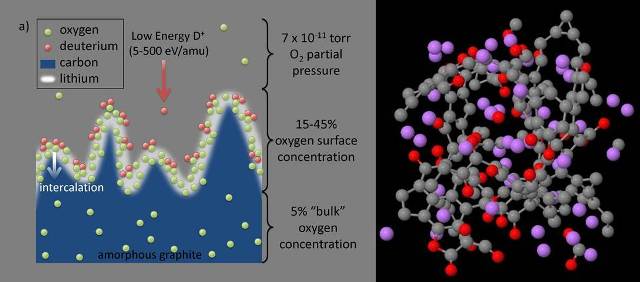Feb 1 2013
The research of a multi-institutional team from the U.S., Japan, and France, led by Predrag S. Krstic of the Joint Institute for Computational Sciences and Jean Paul Allain of Purdue University has answered the question of how the behavior of plasma—the extremely hot gases of nuclear fusion—can be controlled with ultra-thin lithium films on graphite walls lining thermonuclear magnetic fusion devices.
 Caption: Dynamic in lithiated graphite: a) Experiments show that deuterium bombardment dramatically increases the surface oxygen; b) Simulation shell for the D-impact chemistry in lithiated and oxidized carbon
Caption: Dynamic in lithiated graphite: a) Experiments show that deuterium bombardment dramatically increases the surface oxygen; b) Simulation shell for the D-impact chemistry in lithiated and oxidized carbon
"It is remarkable that seemingly insignificant lithium depositions can profoundly influence the behavior of something as powerful as fusion plasmas," Krstic said.
Krstic and his team explain their research in a paper titled "Deuterium Uptake in Magnetic Fusion Devices with Lithium Conditioned Carbon Walls," recently accepted for publication in Physical Review Letters.
"How lithium coatings on graphite surfaces control plasma behavior has largely remained a mystery until our team was able to combine predictions from quantum-mechanical supercomputer simulations on the Kraken and Jaguar systems at Oak Ridge National Laboratory and in situ experimental results from the Purdue group to explain the causes of the delicate tunability of plasma behavior by a complex lithiated graphitic system," Krstic said. "Surprisingly, we find that the presence of oxygen in the surface plays the key role in the bonding of deuterium, while lithium's main role is to bring the oxygen to the surface. Deuterium atoms preferentially bind with oxygen and carbon-oxygen when there is a comparable amount of oxygen to lithium at the surface. That finding well matches a number of controversial experimental results obtained within the last decade."
The performance demands on plasma-facing components and the other materials that would surround future fusion power reactors is one of the reasons the U.S. National Academy of Engineering has ranked the quest for fusion as one of the top grand challenges for engineering in the 21st Century. Harnessing energy from thermonuclear magnetic fusion has been challenged in part by the extreme environment of hot and dense plasma interacting with the boundary fusion reactor walls. The strong coupling between the plasma edge and the wall surface, which causes erosion of the wall material, retention of radioactive tritium, and pollution of the plasma, has been hampered by a lack of fundamental understanding of what takes place at the interface where the plasma and solid material meet.
Recent research in which lithium coatings have been deposited on a variety of metallic and graphitic surfaces has provided evidence that plasma strongly responds on the deposited films. In fact, the use of ultra-thin coatings of lithium on graphite has resulted in an unprecedented influence on plasma behavior, including control of hydrogen recycling—one of the most important issues in the construction of future magnetic fusion-energy devices—and extraordinary improvements in energy confinement.
The study of the lithium coatings also impacts many areas beyond magnetic fusion, including nanoelectronics, lithium batteries, computational materials science, bioengineering and biophysics, plasma physics, and theoretical physics and chemistry.
"This work can lead to improvement of the hydrogen-recycling properties of the fusion materials facing plasma, as well as advancements in other areas," Krstic said. "We hope that our finding will inspire future theoretical and experimental work in diverse applications not only with lithium coatings on various materials but also with combinations of other types of materials that are potentially good 'oxygen-getters'—for example elements of the first two groups of the periodic system."
Source: http://www.nics.tennessee.edu